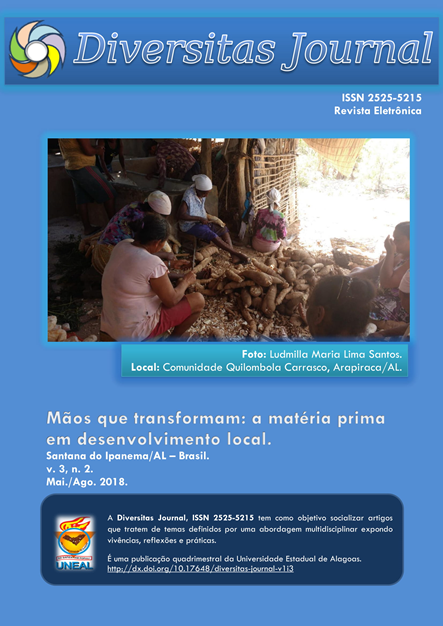Continuidade e persistência de comportamentos sociais: as práticas repressivas do Estado brasileiro
DOI:
https://doi.org/10.17648/diversitas-journal-v3i2.590Abstract
RESUMO: A proposta deste artigo foi confrontar as práticas do policiamento ostensivo brasileiro do século XIX com expressões institucionais atuais. O presente esforço é parte integrante de uma proposta mais abrangente de constituir uma “teoria genética” da instituição policial militar brasileira. Partiu-se de um suporte teórico alinhado à reprodução cultural de Pierre Bourdieu (2011), mas ao encontrar evidências de elementos históricos e “a-temporais” postergou-se para futura investigação o uso de outro quadro de referência. Por hora, baseado nas obras historiográficas de Mauro Baldo (1980) e Líbano Soares (1999) chegou-se a alguns elementos regentes da atuação repressiva estatal: as figuras do capitão-do-mato, do feitor ausente das plantations e do homem branco pobre e livre.PALAVRAS-CHAVE: Reprodução cultural. Sistema escravocrata. Violência policial.
ABSTRACT:The proposal of this article was to confront the practices of the ostensive Brazilian policing of the XIX century with current institutional expressions. This effort is an integral part of a more comprehensive proposal to constitute a "genetic theory" of the Brazilian military police institution. It was based on a theoretical support aligned with the cultural reproduction of Pierre Bourdieu (2011), but when finding evidence of historical and "a-temporal" elements, the use of another frame of reference was postponed for future research. For the time being, based on the historiographical works of Mauro Baldo (1980) and Lebanon Soares (1999), there were some regent elements of the state repressive activity: the captain-of-the-mato figures, the absentee farmer of the plantations and the poor white man it's free.
KEYWORDS: Cultural reproduction. Slave system. Police violence.Metrics
References
BALDO, Mario. O Capitão-do-mato. [Dissertação] Programa de Pós-graduação em História do Brasil. Curitiba: UFPR, 1980.
BOBBIO, Noberto. Estado, Governo e Sociedade: Para uma Teoria Geral da Política. 16a. reimpressão. Editora Paz e Terra, 2010.
BOURDIEU, Pierre. O Poder Simbólico. 15a. ed. Rio de Janeiro: Bertrand Brasil, 2011.
CHESNAIS, Jean-Claude. O aumento da violência criminal no Brasil. Revista Justitia, São Paulo, Edição 177, Jan-Mar. 1997; p.p. 18 -47.
CRUZ, Lara A. O tradicional e o moderno na formação do policial militar: uma análise do curso de formação dos soldados do Ronda do Quarteirão. [Monografia] Centro de Estudos Sociais Aplicados. Fortaleza: UECE, 2012.
LÍBANO SOARES, Carlos E.. Escravos, senhores e policiais: o triângulo da desordem no Rio de Janeiro de Dom João VI. Revista do Mestrado de História, ano II. Vassouras-RJ, 1999.
OLIVEIRA, Adriano. Um estudo etnográfico da instituição Polícia Militar In: NEVES, Paulo S. da C. et al. (Org.). Polícia e democracia: desafios à educação em direitos humanos. Recife: Gajop/Bagaço, 2002.
SILVA, Wellington B. Entre a liturgia e o salário: a formação dos aparatos policiais no Recife do século XIX (1830-1850). [Tese] Progrma de Pós-Graduação em História. Recife: UFPE, 2003.
SOARES, Luiz E. Aplausos a Violência? Acesso em 23 out. 2013. Disponível em . Publicado em 2008.
____. Reforma da Arquitetura Institucional da Segurança Pública no Brasil. [On-line] Acesso em 05 ago. 2013. Disponível em <http://www.luizeduardosoares. com/?p=997>. Publicado em 01 mar. 2010.
ROCHA, Alexandre P. Polícia, violência e cidadania: o desafio de se construir uma polícia cidadã. Revista Brasileira de Segurança Pública, v. 7, n. 1, 84-100. São Paulo: fev./mar. 2013.
SILVA, Wellington B. Entre a liturgia e o salário: a formação dos aparatos policiais no Recife do século XIX (1830-1850). [Tese]. Programa de Pós-Graduação em História. Recife: UFPE, 2003.
VASCONCELOS, Ruth. Vida e Morte: uma “batalha de gigantes”. In: XI Colóquio Internacional de Psicossociologia e Sociologia Clínica. Belo Horizonte, 12 abr. 2007.
ZALUAR, Alba e LEAL, Maria Cristina. Violência extra e intramuros. Revista Brasileira de Ciências Sociais - Vol.16 n.45. fev. 2001, pp. 145-164.
ZIMBARDO, Phillip G. Efeito Lúcifer: Entendendo como pessoas boas se tornam diabólicas. São Paulo: 2008.
FOLHA ON LINE. Onde está Amarildo? [On-line]. Folha de S.Paulo - Opinião - Amarildo, 43. Disponível em <http://www1.folha.uol.com.br/opiniao>. Acesso em 23 out. 2013. Pulicado em 03 ago. 2013.
UOL Notícias. As reviravoltas do caso Amarildo. [On-line] Publicado em 23 jun. 2015. Acesso em 10 jul. 2015. Disponível em <https://noticias.uol.com.br/cotidiano/listas/as-reviravoltas-do-caso-amarildo.htm>.
Downloads
Published
How to Cite
Issue
Section
License
Copyright (c) 2019 Wagner Soares de Lima, Patricia Soares de Lima

This work is licensed under a Creative Commons Attribution 4.0 International License.
The Diversitas Journal expresses that the articles are the sole responsibility of the Authors, who are familiar with Brazilian and international legislation.
Articles are peer-reviewed and care should be taken to warn of the possible incidence of plagiarism. However, plagiarism is an indisputable action by the authors.
The violation of copyright is a crime, provided for in article 184 of the Brazilian Penal Code: “Art. 184 Violating copyright and related rights: Penalty - detention, from 3 (three) months to 1 (one) year, or fine. § 1 If the violation consists of total or partial reproduction, for the purpose of direct or indirect profit, by any means or process, of intellectual work, interpretation, performance or phonogram, without the express authorization of the author, the performer, the producer , as the case may be, or whoever represents them: Penalty - imprisonment, from 2 (two) to 4 (four) years, and a fine. ”


















